Forward
John Whittemore was Minnie Whittemore Nichols older brother. What follows is known to us, the Nichols cousins, as Uncle John’s diary. My personal feeling is it is more like his memoirs, hence the title page. Joyce Nichols Ritter transcribed it in 1986 and 1987. That was about 20 years ago as I sit with it today. The chapter headers are mine. I introduced them, as they seemed to fit naturally. I have also added pictures to help us see some of the people and places John talks about in his story. As you read it keep in mind that John was born in 1881 and died in 1958. Therefore, his discussion of his childhood in Hebron takes place in the 1880’s and it is most likely that this was written the in 1950’s about half a century ago. Without question this diary provides a unique insight to the daily lives of our ancestors. I hope you enjoy it as much as I have.
Ernie (Butch) Danforth (2007)
I.The Whittemore Genealogy
Josiah Whittemore and Betsey Foster, my paternal great grandparents were married May 6, 1805. Josiah Whittemore was born Oct 25, 1784 and died May 17, 1870. Betsey Foster was born March 13, 1787 and died March 13, 1854.
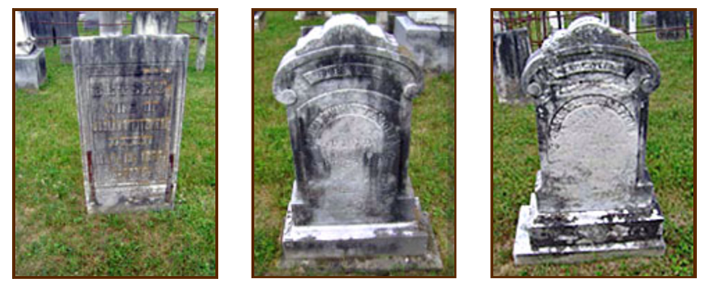
| Their Children’s names were as follows: | ||
|---|---|---|
| Children | DOB | DOD |
| John Dexter | March 31 1809 | |
| John Foster | Dec 27, 1814 | September 29, 1899 |
| Elizabeth May | February 24 1817 | |
| Martha | April 12, 1819 | |
| Children | DOB | DOD |
| John Dexter | October 6, 1841 | June 24, 1861 |
| Myron Brayton | October 3, 1843 | May 13, 1893 |
| Byron Bowen | October 3, 1843 | July 24, 1887 |
| Edward Carr | June 22, 1846 | August 1909 |
| Charles | August 14, 1849 | February 2, 1909 |
| Foster | February 20, 1852 | September 3, 1853 |
| Mary Calista | August 31, 1857 | 1907 |
Parents of Calista Maletta Brayton Whittemore, my grandmother, were Carr Brayton, born Sept 9, 1797 and Mary Bowen, born August 7, 1797. Their children’s names were as follows:
| Children | DOB | DOD |
| Calista Maletta | March 7, 1819 | October 15, 1878 |
| Mary Ann | May 6, 1821 | |
| John J | May 17, 1823 | |
| Charles C | March 26, 1826 | |
| Samuel S | September 21, 1828 | |
| Stephen | Aug 15, 1830 | |
| Amanda | December 25, 1832 | |
| Lydia Almeda | July 27, 1838 |
| Children | DOB | DOD |
| Mary Louise | October 20, 1854 | Dec 2, 1913 |
| Harriet D | Aug 13, 1857 | Dec 24, 1905 |
| Horatio C | Aug 13, 1857 | Feb 9, 1906 |
Myron J. Wiltsey and Harriet D. Slocum were married Oct 9, 1877. Myron J. Wiltsey was born Sept 8, 1855.
Horatio C. Slocum and Jennie M. Sweet were married Oct. 1, 1888. Jennie M. Sweet was born November 16, 1864, died (?).
I think Charles Whittemore and Mary Louise Slocum, my parents, must have started keeping house on a farm over in the town of Hebron, Washington County, New York in 1876 and lived there 18 years. They were married Jan 19, 1876.
Charles Whittemore (born Aug. 14, 1849. died Feb. 1, 1909)
Mary Louise Slocum (born Oct. 20, 1854, died Dec 2, 1913)
Following are the names of their children.
| Children | DOB | DOD |
| Charles Herbert | Sept 29, 1878 | Apr 20, 1953 |
| Jennie Louise | Nov 20, 1879 | Dec 20, 1947 |
| John Warren | April 10, 1881 | Feb 17, 1958 |
| Harriet Maletta | Jan 15, 1883 | Mar 24, 1888 |
| Mary Calista | Mar 9, 1885 | Dec 3, 1952 |
| Edward Byron | Mar 20, 1890 | |
| Myron Josiah | Aug 28, 1895 |
II. The Hebron Farm
It was while Charles and Mary Louise Whittemore were living on this, my hilly Hebron farm, that 6 of their children were born.
I think I can remember back to when I was 4 years old. As soon as I was old enough and big enough, and I think it started about that time, I was taught to do certain chores each day. This also applied to my brother Bert and my sister Jennie.
Our family was poor, times were hard and there were many mouths to feed. Besides the family, there were usually two hired hands, a girl to help Mother and a man 8 months of the year to help Father. These two lived with and were a part of the family.
For economy and for convenience, provender were bought in bulk in those days. Flour was bought by the barrel (196 lbs.) and in our home there was no suitable place to store it, only to carry it up a narrow stairway and store it in a hallway in the chamber. Salmon and mackerel were bought by the kit and a whole salted cod fish, ranging in size, was usually in stock.
I remember Father buying one salted cod that weighed 25 lbs. It was always the custom to preserve the meat from a 450 lb. home, corn, and middling fed hog, or two smaller ones.
This grain was usually mixed with skimmed milk or fresh whey. In addition to hog meat, fowls and sheep were often slaughtered to provide some fresh meat. Then too a hindquarter or half of a well-fatted young beef was part of our larder. This beef was always slaughtered in cold weather and was kept frozen so that a goodly portion of it was consumed as fresh meat. However, a certain portion of it always was preserved.
Preserving fruits, berries and vegetables in large quantities was the custom. Well remember, after going berrying, having to sit down when we arrived home and sort and look those berries over preparatory for preserving. Wonder if any of you have had anything to do with preparing elderberries for using in a fresh pie, canning or drying. If I ever had a tedious job it was shelling elderberries and making sure that all stems were picked off. Mother used to dry a great many apples for pies and that required some labor in preparing them for it. Paring the apple and then slicing it very thin, both operations of which I used to have a part in.
Money was so scarce in my boyhood days that farm produce was, whenever possible, used in exchange for household supplies for the table. Eggs, potatoes and butter were often used as an exchange. Selected shelled corn was taken to the grist mill and ground into corn meal for Johnny cakes, corn meal pudding and other things.
Corn meal pudding was our sure fare for Sunday night suppers. Mother usually planned to make enough so that there was plenty left over which she fried for breakfast Monday morning. On these fried corn cakes we had a choice of brown sugar, honey, Puerto Rico molasses and once in a great while maple syrup. Maple syrup was too expensive for common use.
Father grew his own buckwheat. This grain had to be handled with considerable care or else it would shell in handling and then of course there would be a big loss. Farmers took some of their buckwheat to a grist mill purposely to be ground into buckwheat flour for pancakes.
Many of the less well to do farmers, like my father, tried to grow most of the grain that was used on their farms. Most farmers would prepare what was known as a grist and then take it to a grist mill and have it ground.
A grist would be a quantity of mixed grains, consisting of whatever formula they wished to follow. Father’s was apt to be corn on the comb, oats and rye with a certain % of each. This would all be ground together and how the animals liked it!
This again was where the poor farmer would use his produce to pay his miller’s bill. A toll system was in vogue in those days, which worked this way. If the grist was to be tolled the miller would keep a portion of the grain to pay for the grinding charge and in this way the farmer didn’t have to hand out any cash. With this method the miller was building up a stock of grain, which he had as ready sale for the more wealthy farmers and particularly to people in the villages who owned horses as so many did in those days. Remember, this was back in the horse and buggy days, long before the automobile.
To go back to the preserving of meats, for instance hog meat. There was but little discarded. Quantities of the less choice parts, together with a small % of beef were ground together for sausage. After the grinding process, which we children did the most of and which was hard work, Mother would apply the seasoning of salt, pepper, sage and possible other things. Now it all had to go through the grinder again to insure proper seasoning mixing and proper grinding. After the second grinding it was ready to be put in the containers which were long slim bags made of a sort of cheesecloth. The sausage was packed in these bags as tightly as was possible and the bags were usually hung in a cool place.
Housewives in those days made their own shortening, namely, lard. This was made from the fat of the hog which was melted and clarified. Two kinds of lard were made, the better of which was called leaf lard.
The hogs were thoroughly cleaned, scaled, scalded, parboiled and baked and produced a savory meat which was called souse. The meat of the hogs head was treated much the same way, was ground, mixed with bread crumbs, seasoned, I think pickled in some way and then pressed into molds and come out that which was called head cheese.
The hams and shoulders were put through a pickling process, after which they were smoked over a smoldering corn cob fire.
Some farms had an ash house, rigged so that the hams and shoulders could be hung within the house and subjected to this smoldering smoky fire. However, the Hebron farm didn’t have this convenience so Father had to improvise a smoke shelter which he did with good results. He took a wine of vinegar cask, put dirt in the bottom, built a smoldering fire of cobs, put a crow bar (a metal bar) across the top to hang the hams on, put a cover on and awaited results.
It was quite common for farmers to make a % of the soap they used. About the only soaps that I remember were on the market were Castile, Ivory and Babbits, all hard soaps. A great deal of soft soap was used in those days and this was a farmer product.
I will briefly describe my parents’ method of manufacturing it. Our fuel was mostly hardwood and the ashes from this fuel was stored under cover until the season of making soap, which in our case, was in the spring. Father obtained a slate slab large enough to accommodate about 6 wooden barrels. He made a drain board of the slab by chiseling some grooves in it converging them all to one center groove. He then placed it tilting it so that fluid would run in one direction and to a central point.
The bottoms of these 6 barrels were bored full of small holes and then the barrels were filled with hardwood ashes. Now water was added to these ashes daily but not too much at any one time. In the course of a few days a red liquid started to run from these barrels and flowed down this drain board and into a container. This liquid is lye and is mixed with fats and soluble scraps that have been saved. In due time this lye completely dissolves this soluble matter into a semi-solid substance that quivers when shaken but will not flow. It really jellies it and this is soft soap which was much used in the earlier years, especially for washing clothes. This contraption and process was known as a leach.
The Hebron farm that at one time was called the Whittemore farm is located at the extreme north end of the town of Hebron. The north line fence of this farm is the boundary line between the town of Hebron and Granville. It is on the main road between West Hebron and Granville, a road which within the last 10 years has been somewhat graded and black topped.

North Hebron had a Post Office, receiving its mail through Granville, but I think only twice or thrice a week. It had quite a good general store, a wood working wagon repair shop, a blacksmith shop. A Baptist Church, a sizable school house with a town hall occupying the second story, a cheese factory, several good modest dwellings and just outside the village a cemetery and a half mile horse racing track which also accommodated a baseball field. The latter was privately owned but free for most occasions.
The village also had an adult brass band which played at picnics, rallies, horse races, ball games and other functions.
South Granville, also had a Post Office, had a small general store, a small district school house, a Congregational Church, a cheese factory and possibly a dozen dwellings. I think South Granville was our mailing address with the mail but 2 or 3 times a week. Brother Bert, sister Jennie and I used to attend church and Sunday School here somewhat.
Slateville about 1.5 miles east of us, if we followed the road, shorter if we went across lots as we often did, was reached via a cross road from our farm. This little hamlet was on the main road from North Hebron to West Pawlet, Vt., our nearest railroad station. It derived its name from the quarrying and manufacturing of roofing slate which was being done there during my early boyhood days.
This little village had a country store, a blacksmith shop, a district school house and a very few residences. This is where I went to school. These slate quarries were within � mile from the schoolhouse and were producing an uncommon roofing slate on account of its color. It was red slate, which was rather scarce in those days.
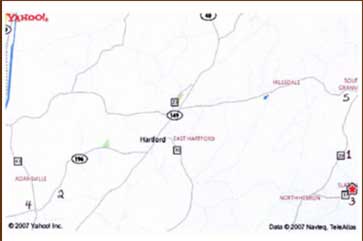
III. Lessons in Honesty
The years between the time when I was able to remember and 1898 went by without really any major event in my life. During that time, I presume I thought I was creating history but it probably boiled down to the fact that I was just leading a normal life of any poor farmer boy. During those years I was a schoolboy, a chore boy and a naughty boy. I was a bully, I was mischievous and I did some questionable things.
When I was really young, I seemed to have an affinity for currency that is, coins. One day I went to where Father kept his change purse and I took most of the change and went out to an adjoining building where our stove wood was stored and hid portions of it in different places. As luck would have it, I remembered right where I placed each parcel. Just what I expected to gain from all this I don’t know. Of course, father missed the money and to show how stupid I was I announced that I had found some money and the strange part of it was, I found it in different places and the sum and total of what I found pretty much tallied with what Father was short.
I know I must have told some little white lies but am afraid my stories didn’t hold together and I was convicted on circumstantial evidence. My sentence was not as severe as it might have been and I think it was in the nature of a very feeling, reprimanding lecture by Mother. However, I think it had its effect and don’t remember of ever stealing anything again except to take one large nail out of an open keg in a hardware store in West Pawlet when I happened to be in there one day with Father.
Before I got home, I confessed to Father and when he had finished lecturing me I felt very much a criminal. Think that was the last of my thieving.
IV. Chores and the Winter of 1888
When in school, certain chores were expected of all of my parents’ children at both morning before school and at night after school. Saturday and holidays were no exceptions. Won’t say that our parents were unusually exacting, but they did insist that we stick to a schedule. Brother Bert and I had certain chores to look after; the hogs and hens to be fed, the eggs to be gathered and firewood to be brought in to feed two stoves through all the cold winter season. Now comes the rub. Besides the outside work, Bert and I had to do a certain amount of the dish washing and drying, making beds and general house cleaning.
Don’t mean to imply that we weren’t given some time to play. Possibly we were allowed as much free time as our neighbor’s children. Oh yes, we used to play “hide and see,” “drop the handkerchief,” “blind man�s bluff,” “Copenhagen” and such like. Also used to slide down hill, skate, snowball, build snowmen, play “fox and geese” and just tramp throughout the snow for the fun of it. Regret that I never did have time to fish or hunt so am ignorant of any knowledge of either.
The winter of 1888 was a dark one for Father and Mother. My sister Hattie who was 5 years old and two years younger than I, was taken with pneumonia. Bessie Hughes, a cousin, who was teaching school at South Granville and was boarding with Father and Mother, was also taken with it about the same time. Think this must have been about the middle of February.
Soon after, one day in school at Slateville, I was taken with a sudden attack of sickness and my teacher asked a Mrs. Lancaster, who lived near the school, to put me to bed until word could be gotten to my father to come after me.
For me this meant that I was bed ridden for 6 weeks with the same disease and, like the others, critically sick a great deal of the time; some of the time delirious. Dr. John Gilman of West Pawlet attended us as faithfully as he could, coming to us in any way that he could after March 12, 1888, the commencement date of the big blizzard.
Of course this was long before the automobile and the roads were blocked so badly that he had to make the last mile or so to our place on snowshoes. Mother was a wonderful nurse, but of course, it was beyond human endurance for her to meet all the tasks that confronted her, so she and Father persuaded an elderly and non-practicing uncle doctor (Uncle Charles Slocum) to come and live with us and act as a nurse.
It was to no avail so far as Hattie was concerned, all was in vain for she passed away March 24, 1888. Alas, though this tragedy wasn’t enough, sister Minnie, who was 3 years old, come down with the same dreadful disease.
Just how Mother and Father survived this I will never know. I was too sick to sense too much of what was going on. Do remember though the funeral for Hattie at the house, but I think I was too sick to get the real significance of it. Just how it all turned out, in what order the rest of us recovered, I can’t remember. I do recall, however, that the first they let me sit up was on my birthday, April 10th, and I remember so well that the snow of the blizzard of over a month previous was still as high as the fence in front of our house.
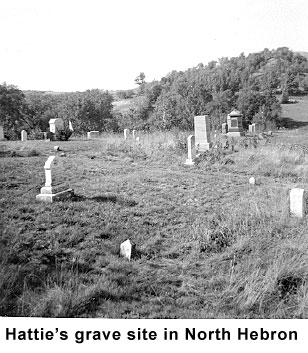
V. Green Pond, Sheep Shearing, and the Hydraulic Ram
Green Pond, a spring fed pond, back on the hills just a short distance from the east boundary of the Whittemore Hebron farm had a great fascination for boys. Adjacent to this pond were clearings covered with high bush black berries; and on the hills surrounding it were many walnut trees. Our parents used to send us after berries or nuts and nearly always after we had filled our pails with berries or nuts, we would either take a swim or paddle around the pond in an old boat, depending on the season of the year. We had some narrow escapes all unbeknown to our parents. I had a few wonderful times skating there. The water is so pure and free of vegetation and the ice like glass.
It was at Green Pond that I learned to swim before my parents knew that I could.
Our sheep pasture was not far from the pond and Father obtained permission from a neighbor to cross his pasture and use his shore line for a place to wash our sheep. This I think was usually done just before shearing time and I think it was done in early May. The object of washing was that washed wool brought a better price than unwashed.
Sheep shearing time was always one of the events of the year, at least so on the Whittemore farm. Sheep shearing used to be as much of a trade as barbering and the nearest ones to us who followed it were over in Hartford. Father usually engaged 3 of them to come on a certain date and they were able to shear our flock in one day. From the fact that it was something different and broke monotony, let alone the excitement it created, it made a real event for me. There was another feature about it that allured me. Mother always fed them and the dinner was more like a Thanksgiving meal, and of course that is when I shone as I always enjoyed eating.
These men were full of fun and enjoyed playing jokes. More than once I was the goat, probably because I made a nuisance of myself by being around underfoot too much and too, I was inclined to play some tricks myself. Remember one of my jokes boomeranged on me. After a course of time the air chamber of our hydraulic ram used to fill with water and to let the water out the plug in the air vent had to be pulled and then the water would spout right up like a fountain. It was my pet trick to invite someone to see our ram and then I would reach over and pull the plug and then the water would spout up in their face. Once I invited one of these sheep shearers (Mr. B. Stafford) to go down and see our ram and he graciously accepted. As usual, when the time was just right, I leaned over and pulled the plug. At that very instant, when I was leaning, he grabbed me and held me right over the stream until I got good and wet. Someone must have put him wise and I always thought it might have been Father or Mother. I took a good kidding from that for a long time.
Now that I have mentioned our hydraulic ram, it might be of some interest to relate how it served us. Down the hill from the rear of our house we had a never failing spring of cold water. Father walled this spring up and built a very substantial house over it. Probably 50 feet still farther down he sunk a well and housed it in and installed a hydraulic ram. Water was piped below the frost line from the spring to the ram. There was enough fall between the spring and the ram to put the ram in operation. Now the ram forced the water up the hill in a lead pipe to a barrel at our pack porch. This water was running into this barrel constantly so of course there was an over flow which was piped to a tub in the barnyard for the stock to drink from.

These several steps of piping this water from the house was made possible by the fact that the house was much higher than the barn and the barnyards and was done by gravity.
VI. Stone Walls and Picking Stones
I have said that some mornings when we went to school to save time we went across lots. One particular morning when we did this, going over fences and stone wall, I had an accident going over the last fence. In jumping from the top rail I sprained my ankle. Even though I could hard step on it I hobbled to school. It kept getting worse, paining me so I could hardly stand it, until noon the teacher said she was going to investigate it. She took my shoe off and in just a few minutes it swelled so that she couldn�t put it back on. She then arranged some way to have me carried home. I then had a little vacation but Mother soon had me going again.
There used to be quite a dread in making that walk to and from school, especially if we happened to be alone. Bear in mind we were only 8 or 10 years old.
About half way to school we had to pass by Mr. Buttons farm and he always had a flock of geese. Don’t think a mad dog could have scared us more than those ganders did when they came strutting towards us with their necks out straight and hissing at us.
But the neighbor boys and I took a lot of chances riding down hill on the North Hebron, South Granville highway leading by our house. Think it was done unbeknown to our parents. Of course, it was all horse traffic and very little of it in those days. There were 2 long hills south of us toward North Hebron with a short flat in between, and then it would level off again somewhat until it got by our house and then all down hill toward South Granville for perhaps a quarter of a mile. All told from the top of the farthest hill to where we would come to a stop was about a mile and a half. If the roads were icy, as they often were, we could belly gut down this 1� miles without stopping. I made this trip once with some of the larger boys on the front bob of a 2 horse sleigh. The trouble with this riding down hill was, while you had a nice ride down, you had an awfully long walk back, dragging your sled. After one had done this two or three times, the enthusiasm was lost.
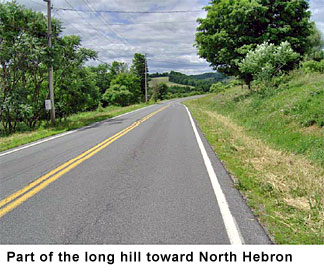
A Mr. William Morehouse who lived at Slateville was an expert wall builder and was in great demand. He laid the stones up dry, wedged small stones in and around the large ones, built his walls straight with even sides which slanted out from top to bottom. All in all, his walls were very secure and artistic.
Don’t think brother Bert and I were naturally dishonest, but speaking of the stones of Hebron reminds me of an act that we pull on Father that borders closely with dishonesty.
Probably I was 10 and Bert 12 when we [Paragraph lost because of poor copy.]
To Bert and me picking up stones was about the worst thing we could do so we decided that we would time Father and while he was over the other side of the hill and out of sight we would sit and take it easy until time for him to appear. We had the advantage of him too because he was operating a mowing machine and before he was entirely in sight the noise of the machine gave us our cue. As he reappeared, he found us working like beavers. He must have been proud of his two industrious growing boys.
VII. Glasses
Until I was 10 years old, I couldn’t see to read the Youth Companion or any other print similar to it, so had to wait for Mother to read the stories to me. I know now, from what I remember, that this was a great concern of Mother’s. She consulted our family doctor several times and the doctor examined me pretty thoroughly and finally he advised my going to Albany and being examined by a specialist (Dr. Merrill) and fitted for glasses.
Well do I remember my excitement over this! The date was set and Father took both Bert and me and we took the train at West Pawlet.
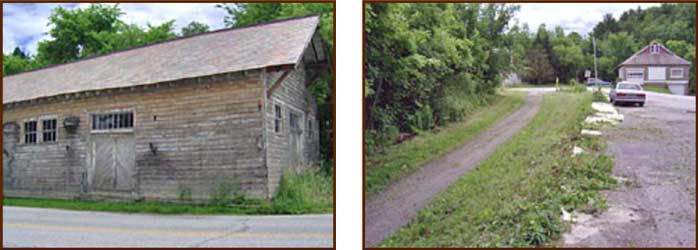
Father did his best to entertain Bert and me, took us to a play at Harmanus Bleaker Hall (don’t know as that is spelled right) (The actual spelling is Harmanus Bleeker. The theater was torn down in the late 1990�s E.D.) at the time the largest and I don’t know but it may have been the only theater there. He also took us through the State Capitol Building, drove by the Executive Mansion and took a trip to the Albany Penitentiary. This was in the wintertime and before we went Father bought both Bert and me 3 buckle cloth top overshoes. These were rather new at that time and I can tell you we were pretty proud to strut those around. Can remember now what a chore it was to put them on and take them off.
When we got home from that trip we had more to tell Mother than a child would now days if they had had a sea voyage.
The embarrassment that I suffered from wearing my new glasses almost spoiled the trip for me. Don’t think I ever saw a child wearing glasses before and I was ridiculed by my school mates aplenty. Was very much mortified the first day that I wore them to school.
VIII. Driving Horses and Picking Potatoes
After I was 10 I was trusted to drive old Nellie horse and take Mother on errands and before I was 13 I was allowed to go various places alone with old Nellie. Used to drive about 2� miles to the store, post office, cemetery and blacksmith shop.
On different occasions took my sister Jennie to Middle Granville, about 8 miles to take music lessons from Aunt Fannie Whittemore.
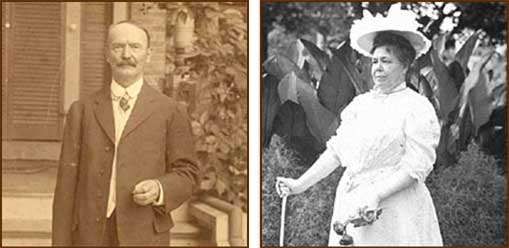
Growing potatoes was the principal industry for the Hebron farmers during my life in Hebron. West Pawlet, Vt. was the shipping point for most of the Hebron farmers and what a busy place it used to be in the fall during potato digging season! Of course the potatoes were drawn by horses and the wagons were equipped with boxes of a 40 to 50 bu. capacity.
Remember times when I went with Father, there would be a long procession of farmer’s wagons waiting to be unloaded in their turn.
Helping dig potatoes and picking them up is something that I always did from the time I was a small boy until I left the farm at 18. When I was too small to dig I pulled the tops and when I was at that age Father bought pack baskets for Bert and me to pick up with.
Speaking of baskets, reminds me that basket making was quite a rural business in those days. There was a class of people over on the hills between Hartford and Granville who were called Gilders. These people used to do quite a business in making baskets, bottoming chairs, etc. They manufactured the splints out of the raw material. At a certain time of year when the sap was in the timber, they would cut small logs or poles of ash, poplar or basswood and then pound them until the fibers became separated. They then would strip them end from end in thin strips, forming their splints. These splints were more workable when green but if they became seasoned, they were dampened to make them pliable.
VIII. Pack Peddlers and Other Travelers
Wonder how many of the younger generation know anything about Pack Peddlers. It might interest some to dwell on this subject briefly. A pack peddler was a person who travels on foot with a pack on his back peddling from house to house. The goods he was peddling was of a very wide variety, cheap jewelry, thread, thimbles, needles, pins, handkerchiefs, stockings, shawls, men’s work shirts, underwear, yard material and lots more. This was all packed in the center of a square of strong cloth, usually bed ticking, and about the size of a sheet. When ready to tie up his goods, he would take opposite diagonal corners, bring them together and tie in a square knot and then do likewise with the other two corners. Finally a strong strap would be buckled around the pack and then the peddler, who had some kind of a harness on would hoist it to his back and attach it to the harness. Many a time I have seen them stagger under loads that seemed impossible to carry.
The keen interest that I have in these peddlers is that one or two of them became, seemingly, one of our family. Father and Mother were very sympathetic with these men. So much so that it soon caught on and whenever they were in our area they would ask, or be asked to stay all night, or possibly a weekend.
One man in particular, Nathan Goldberg, became quite a part of us. He was a gentleman of the highest character and we always greeted him with open arms and am sure that the feeling between him and our family was mutual. He became a wonderful businessman and every year, up to the time of Mother’s death, he sent her a nice Christmas present.
He developed rapidly from a pack to a horse drawn panel cart, to a 2 horse cart and finally to the largest dry goods store in Granville, which is still in existence, and is being operated by his daughter-in-law and, I think, her son. Both Mr. Goldberg and his son are dead.
The other pack peddler, Sigman Weinberg, who started the same way and who used to stay over at our house once in a while, developed equally as rapidly. We didn’t have the respect for him that we had for Mr. Goldberg. However, Mr. Weinberg, before he died, established a large lumber and hardware business in Granville, which is still a thriving business carried on by his son.
Back in those days there was quite a market for old rags, which was used in the manufacturing of, I think, paper. A Mr. Mannis of Ft. Edward had a fleet of covered wagons that he sent out through the country to pick up these rags. These enclosed wagons were known as tin peddlers cars and when started out were loaded with tin kitchen utensils which were exchanged for old rags.
A certain Mr. Tanner traveled our region and he too established our home as an over night or weekend lodging place. Mr. Tanner played an accordion and always carried it with him and we kids were crazy to hear him, and I think Father and Mother liked it too, so that was probably the way he got established with us. He had another man with him as a helper when he stayed over one weekend and I vividly remember how they entertained themselves part of that Sunday.
They played a game which I had never seen played before and don’t know as I have seen played since. Each one took a horse whip, stood facing each other and started whipping each other around the legs as hard as they could. The rule was that the upper body wasn’t to be touched and the game was to test one’s endurance. The one who gave up first of course was defeated. Never saw two men take punishment like that. As I think of it now, it was rather heathenish.
IX. The House in Winter
In this day and age when there is so much stress put on the insulation of houses, reminds me of conditions which were apt to prevail in the old farm houses of yesteryear. In ours at least at Hebron, the only insulation that it got was a banking of leaves or sawdust. This consisted of erecting a tight fence around the house and up as high as the bottom of the windows and out from the house 6 or 8 inches. This enclosure was filled with leaves or sawdust, tramped in, and covered over the top to keep the water out. This banking was put up in the fall and taken down in the spring. This was done as much to protect the cellar from freezing, as it was to help insulate the first story. A great many potatoes and vegetables were stored in the cellar and their preservation was of the utmost importance.
So far as the first story was concerned, it necessitated wearing heavy woolen clothing, long and heavy underwear and burning plenty of hard maple or hickory wood. Even then, in severe weather, you might be warm on the side nearest the stove and cold on the other.
There was no attempt to heat the bed chambers of our house only as possibly some heat came from the stove pipe which came from the stove up through the floor and then across the room into the chimney. It was not uncommon for us to find little drifts of snow in our room around our windows, in the morning.
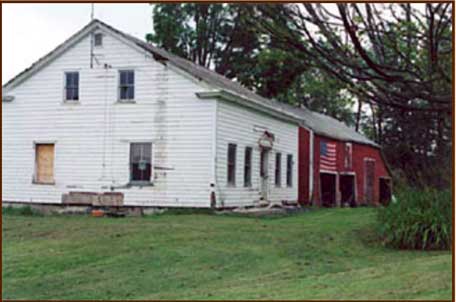
X. The Grounds of the Farm
On the back of our house was a porch and from which one could look down into the valley or off on the high hill toward Green Pond. In the valley, just below the house, was a marsh where sweetflag grew rather well. In the summer evenings the fire flies used to flit about there a great deal and twinkle their lights. Believe it or not, I can remember when I was very young, of Mother sitting there in the evening, holding me and telling me funny tales about those little lights blinking She, too, was apt to finish by singing me a lullaby that ended the day for me.
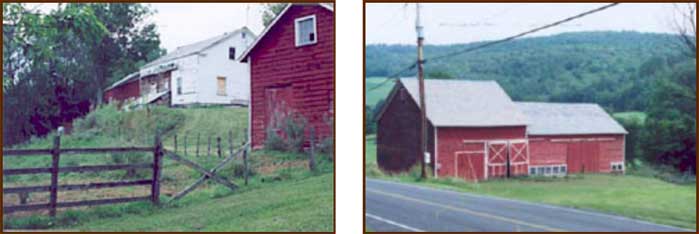
The Whittemore farm had quite a sizable and productive orchard. As my memory serves me we used to sell from 50 to 100 barrels of apples yearly besides reserving enough for our own use.
The custom was, the buyer of the apples would send men called apple packers, to sort and then pack them in barrels. The apples were handled carefully so not to bruise them and the top of the barrel was finished off with selected ones called facers. After the barrel was filled the heads of barrel were put in position and then were squeezed down with a squeezing device and then the head nailed in. Perhaps this squeezing bruised a few, but it compressed them so tightly that in handling the barrels there was no movement of the apples in the barrels, which if there had been all of them would have been bruised and spoiled.
XI. James Flack and Schoolmates
A young man by the name of James Flack, who was somewhat older than I and who was peculiar, used to visit us once in a while and stay a few days. He was not a relative but he was from Hartford and he was so odd that I think Mother took a little pity on him and befriended him.
(My guess is that this is the same James Flack who put together the Whittemore genealogy for Mom (Aunt Louise) in the 1940�s. He was 8 or 9 years older than John and actually a cousin of his, but a third or fourth cousin so John may not have been aware of it. E.D.)
I didn’t like him and pestered him whenever I could. One Sunday he went to church at South Granville with Bert, Jennie, Minnie and me. There were five of us sitting on the one and only seat of the buggy and I, being the driver, was one of the five who had to sit on somebody’s lap and I think I sat on Flack’s lap.
I was wearing my best hat, which probably was a cheap felt hat without any binding on the rim, think they call them snap rims now. We had nearly reached home and I know I was pestering Flack in some way and suddenly he grabbed the rim of my hat in his teeth and bit a chunk out of it as clean as though it had been sheared out.
Think my punishment for that was that I had to wear that hat in that condition for some time afterwards. My trips away from home in those days were few and far between so probably it didn’t bother me too much.
As a matter of record I am going to list the names o 3 of the teachers who taught at Slateville while I attended school there. Their names follow: Libby Keefe, May Braymer, and Herbert Martin.
Also am listing the scholars’ names: Richard Brayer, George, Walter and Jay Button, Luke and Lilliian Garvery, Amy Hill, Nellie, Bert and Geroge Keefe, Carl, Stella and May Lancaster, William H. Layden, Bert Morehouse, Julius and Cora Woodard and Bert, Jennie and John Whittemore.
XII. Final Thoughts on the Hebron Farm
Before ending the history of the Hebron farm, I wish to mention that some of the work on that farm was done in a primitive way and at that time had to be done that way.
The hills were so steep that ways of cultivating them had to be improvised. A good deal of he plowing had to be done with a side hill plow.
All of the grain was cut by hand. The implement used was called a cradle which was a scythe with wooden fingers attached. To operate the cradle, like many farm implements, one had to be versed in it to do it efficiently. All of the grain was raked by hand.
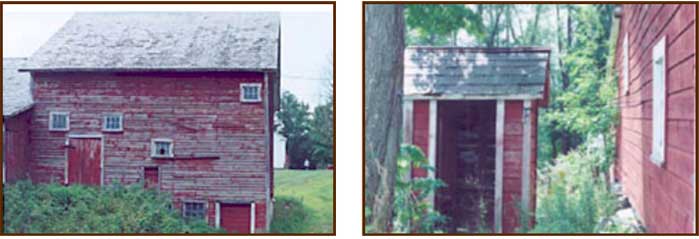
Cows were milked, stables were cleaned and the litter disposed of, all by hand labor.
Am not forgetting the arduous work the housewife was subjected to. Well do I remember how Mother slaved over a washtub, rubbing the dirt out over a washboard and wringing the clothes out by hand. Can remember the first wringer and washing machine that we had which came years later. In fact the washtub rubbing board system lasted for years for Edith had to do it this way for some time after we were married.
Even the water had to be heated in a large copper boiler on the top of the kitchen stove. These were just a few of the hardships that people of years ago had to put up with.
The Hebron farm is a narrow farm and the road crosses it the narrow way, about in the center. Think it must extend back a half-mile or better each way from the road.
The road and the buildings were in a valley and the hills on the west side of the road start directly in front of the house. The hills on the east side of the road are reached by passing down a short lane and crossing a brook where the hills start abruptly.
Father’s produce, hay, grain and potatoes, had to come down these hills over dugout roads and the hills were so steep that always one rear wheel of the wagon had to be chained so that it would slide. At times both rear wheels had to be chained. The wheels didn’t really slide for if they had the tires would soon have been worn out. Instead Father had steel shoes forged for the wheels to enter and these shoes slid while the wheel remained idle. When these shoes became worn thin, as they were bound to sooner or later, they were taken to a blacksmith and reshod.
XIII. The Move to the Adamsville Farm
This narrative so far has pretty much concerned the life of John W. Whittemore during his short career in the town of Hebron, Washington County, New York.
It has not been an orderly continuous account of events as they were related to him but have been set down at random as they were recalled. Other events may come to mind and if they do, regardless of their continuity I will be tempted to record them. However, I now am about to move forward to another chapter in my life.
Uncle Myron and Aunt Emma Whittemore and their two daughters Mamie and Elizabeth, occupied the Adamsville farm for many years and made a home for Grandfather Whittemore.
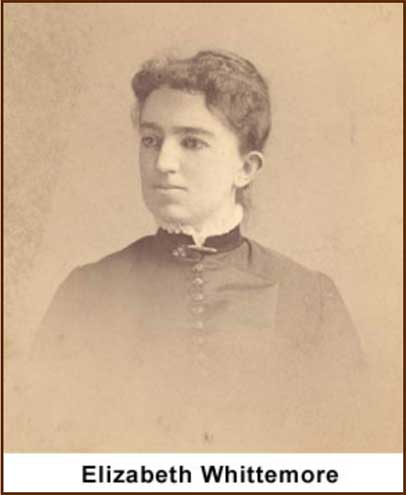
During that summer it was arranged that Father and Mother, with our family, would move there and take over. The Hebron farm was rented to Mr. George Wilson.
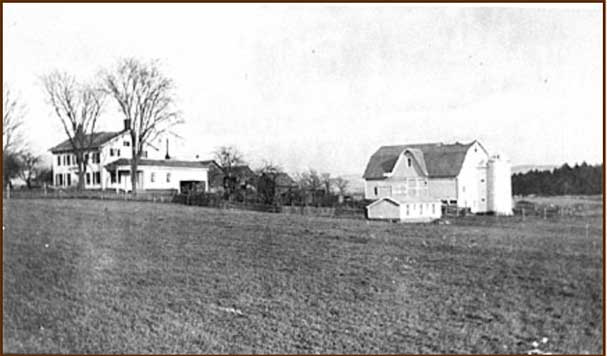
When time came to move that spring of course our stock of cows and sheep had to be driven over land, a distance of 15 miles. This required two trips and brother Bert and I had to do the walking on both trips. We not only had to walk these 15 miles but had to run many extra steps to head the stock off from leaving the beaten path. Our hired man accompanied us with a horse and wagon and on the last end of the sheep trip it became necessary to occasionally load a sheep in the wagon and give it a rest and then take on another.
When we moved to Adamsville (about April 1, 1894) Bert was 15 years old, Jennie 14, I was 13 the 10th of that April, Minnie 9, Ed 4, and Myron wasn�t born until August 28 of that following year.
Commencing about now, Bert and I really had to take over our share of the work with Father and the hired man. Bert had to help care for the cows and help milk them and I helped to look after the horses, which included grooming them besides feeding and watering them and cleaning the stable. I also helped care for the sheep.
The Adamsville farm had 3 sets of barns and 2 houses, the main house and the tenement house. The 3 barns were the main barns, the lower barns and the Lunday barns.
The lower barns were probably � of a mile from the main house and we housed one flock of sheep there, which Father took care of. At the Lunday barn, which was � of a mile from the house, we housed another flock, which I looked after. We of course had to go twice a day to care for these sheep and I either drove old Nellie or rode her horseback. This shepherding of the sheep only had to be done during the winter months.
XIV. Life on the Adamsville Farm
When Bert and I were not in school we had to help with the fieldwork. The first summer that we were there I was trusted with a pair of horses and did most of the mowing of the hay and practically all of the raking. Father planted a good many acres of potatoes the few years that I was home on the farm. Remember one year he shipped 1,000 bushels to New York City and only cleared 13 cents per bushel for them. Raising potatoes required a great deal of labor and we used to put in long days. It was our custom in the summer to arise at 4 in the morning and work until dark. Don�t recall that during these years that I was ever too dissatisfied with life for I really knew no other way.
Always arose early, worked hard both at school and at home and if there was any time for playing, played hard and, consequently, was content to retire early. Never received any wages for my labors, neither did I expect any. Don’t think I ever was given an allowance so the only spending money that I ever had was a little handed out on special occasions.
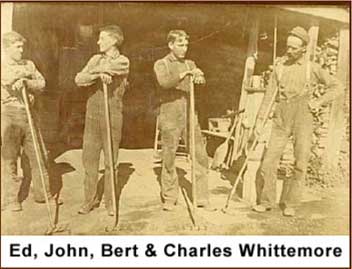
My life on the Adamsville farm only covered the first 4 years following April 1st, 1894 and then part of each of the next 2. To me these first 4 years were very common place.
Worked on the farm during the summer months and attended our small district school in the winter. Our school had an enrollment of about 20. This schoolhouse was a good mile from our home, and in the winter time, when the snow was deep, I was allowed to take old Nellie, hooked to our old square box cutter, and carry Jennie and Minnie to school. Father had arranged for me to stable Nellie in a barn near the school during the day time. When school was dismissed at night I would load up the old square box cutter with Jennie and Minnie and as many of our neighbor�s children as I could load in and then head for home. Usually on the way home I would manage to tip over once or twice but we all were young and enjoyed the fun.
Think Bert attended Sandy Hill High School from September 1894 to June 1895. He taught in district schools through the next 3 school years and then went to Oneonta State Normal in September of 1899. He quit school in November of that same year to accept a position with Griffin Lumber Co.
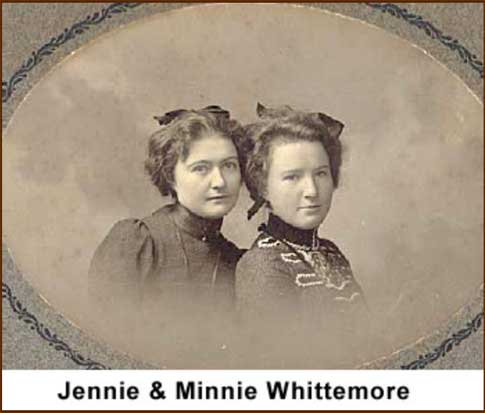
I attended our district school during the school terms from about April 1st, 1894 to January of 1898. Attended Middle Granville from January 1898 to June of 1899 and lastly Glens Falls high from September of 1899 to Feb. 1900.
The history of Minnie’s, Ed’s, and Myron’s district and high school training is rather hazy to me as I was away from home during most of that time.
My life on the Adamsville Whittemore farm from April 1, 1894 to January 1899 was pretty much without incident so far as I was concerned. Didn’t have a girl friend and but few boy friends. Think I attended the Baptist Church at Adamsville rather regularly but there was nothing about it that fascinated me, just something to do to break the monotony. The minister was a far cry from one who would interest young people. In fact he wasn’t an educated man and I had reasons to question his sincerity. He was not an ordained minister.
XV. Trips
Bert and I were allowed to go to Ft. Edward to visit our cousins, Warren and George Wiltsey once in a while and they in turn visited us and on these occasions we always had fun.
(The Wiltsey boys were sons of John’s mother’s sister Harriet. E.D.)
During one of these years that I was on the Adamsville farm the Sandy Hill Methodist Church organized an excursion with the D&H Railroad Company and the Lake Champlain Steam Boat Co. to go to Burlington, Vt. and return. The Wiltseys, Mother’s sister and her husband, got Father and Mother interested to the extent of letting Bert and me go with the Wiltsey boys on that trip. The Wiltsey boys boarded the train at Ft. Edward and Bert and I at Smith’s Basin. We left the train at Port Henry and went aboard the boat and crossed to Ft. Frederick where we all went ashore and had our dinner.
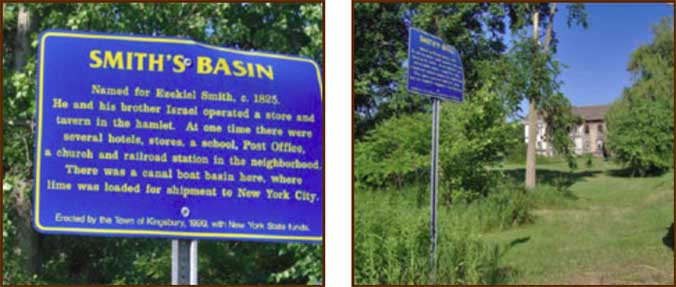
The next summer there was an all rail excursion to Ausable Chasm and again the Wiltsey boys, Bert and I took it in. This was another all day and part of the night affair and as before, we had a grand time.
On one day of the Cambridge Valley Fair, in one of the years that I was on the Adamsville farm, I launched out early in the morning with Father’s best road horse and buggy and picked up Miss Maria Marshall, a young lady in our neighborhood, and went to that fair. It was an all day and part of a night trip. To go the shortest and most direct route would be 60 miles round trip. There were no improved roads in those days, just took as straight a line as possible, regardless of whether it was over hills or through valleys. As I remember it, we arrived at the fair grounds before noon and didn’t leave for home until late afternoon.
There really was no good swimming hole for us boys near the Adamsville farm so some hot nights Bert, John and Charles Cavanaugh, neighbor boys, and I would walk across lots to what was known as the “deep hole” in East Creek on the Hartford-Smith’s Basin road. This was at least a 4-mile round trip walk after working all day. John and Charles Cavanaugh were about our age and lived on the first farm south of us.
During the 5 years that I was on the Adamsville farm I became the teamster next under Father. For most of that time, during the summer seasons, I carried our milk to the cheese factory at South Hartford or to the creamery at Smith’s Basin. This trip was done early in the morning before breakfast.
I made many trips to the gristmill with a grist, after a load of coal or a load of commercial fertilizer. Bert and I used to deliver loads of potatoes and on our return bring back a load of merchandise. The horses had to walk all the way, due to the heavy loads, and the trip from Sandy Hill home would take as much as 3 hours at times and some of the trips in the winter time were almost unbearable on account of the cold.
Father used to put up at least 16 cords of hardwood for fuel each year. Bert and I, with a pair of horses, spent many of our winter Saturdays drawing this out of our wood lots.
XVI. Finishing School
During the latter years of my stay at home, I had to carry Jennie to where she was teaching Sunday nights and go after her Friday nights. I also had to take her to and from Sandy Hill weekends when she was attending school there. Some of these trips were made when the roads were bad, deep drifts hiding roads and snowing and blowing hard. More than once we tipped over, broke the harness once but never did we get into trouble so but that we made the trip.
On one of my trips home from Sandy Hill with a pair of horses and heavy wagon loaded with some kind of merchandise, I lost a parcel off from the wagon seat and a wheel ran over it. The parcel was a brown derby hat that I had bought for myself. Of course it ruined it but the sad part of it was that the pocket book couldn’t afford another. It was a pretty sad time for me, and Jennie or Mother tried to patch it up but it still carried the scars and I felt ashamed to wear it, which I had to.
I guess this is as good a time as any to tell about the first train trip that I took alone.
Bert was teaching in a district school back up in the hills of Dresden, Washington Co. and he either invited me or I invited myself to spend a weekend with him. The date was set and it was early fall or late spring but can’t remember. However, Father took me to Smiths’ Basin to board the train one Friday afternoon and my destination was Chubs Dock now Clemons. Arrived there O.K. but when I got off the train there was no Bert to meet me as had been agreed. I was young and was not experienced and can assure you that I was greatly worried. Well this condition didn’t prevail but a few minutes for Bert soon came out of his hiding and was I glad to see him! Bert had been playing a trick on me.
Right away we started walking up the mountain to Mr. Steele’s residence, which was about half way up, and was on the road leading over the mountain to Huletts Landing on the east shore of Lake George. Mr. Steele was Bert’s trustee and it was with the Steeles that Bert made his home. We arrived in time for supper and then spent a quiet evening visiting. After breakfast the next morning we started walking for Huletts Landing.
This was the first time that I ever saw Lake George. It looked so inviting that Bert and I picked out a secluded spot and then went in bathing attired in our birthday suits. We didn’t tarry too long for we had a long walk back up hill over the mountain. Think from Clemons railroad station on Lake Champlain to Huletts Landing, Lake George is about 6 miles and there is a mountain in between. We got back in time for a somewhat belated dinner and then it was get a hustle on and start walking again to catch my train for home. Father was at Smith’s Basin to meet me and though I had been gone only about 24 hours it seemed much longer and did I have things to talk about and think about!
Along with our hard work we boys when we were on the farm managed to have some fun playing pranks on one another especially when Uncle Horatio Slocum, Mother’s brother, lived with us. Father would hire him in the fall if he was available during potato digging season, as an extra, and he mixed in with us boys like one of us. He was as young in heart as most young men. I recall one night after he had gone to bed and was asleep of decorating my face with old fashioned sulphur matches to resemble a skull and cross bones. By wetting this sulphur and rubbing it on one could obtain most any kind of fiery design if it was exposed in the dark. Well I entered his dark room in this condition, stood over him stared at him and then awakened him suddenly. Needless to say he was quick to react.
He jumped out of bed and chased me back to my room and gave me a good spanking
right [page missing, picking up in mid sentence on next page]…
They didn’t feel able to take me into their home again so instead of going back to Middle Granville to school as I had hoped to, Uncle Ed arranged for me to go to the Glens Falls school. He asked his and Father’s sister, Aunt Minnie Gilchrist, to make a home for me through the school year.
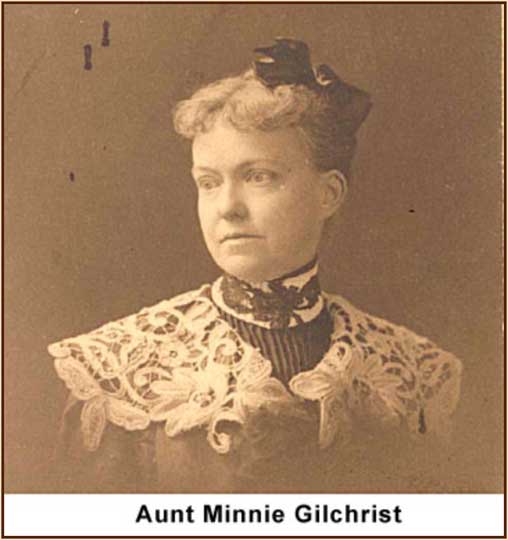
One particular boy, about my age, tried to make a spectacle of me, and so I had to fight him one day right in the school room while school was in session. I had acquired some strength from doing farm work so when I grabbed him I wasn’t long flooring him. At that point we were stopped but he promised me a thrashing that night after school. I told him I would accommodate him and I left that night from the main entrance my usual exit place, but he didn’t put in an appearance. We both were called before the Superintendent, but in the end I was upheld, both by the teacher in whose room we studied and by the Superintendent. Even the young man who started the fracas showed me the utmost respect throughout the remainder of the school year. He was of a well to do Glens Falls family and I occasionally saw him after I left school and he always greeted me most friendly.
XVII. Early Working Years
I went through the January regents examinations, passing all that I tried. At that time I was taking commercial arithmetic, English, physics and bookkeeping. Had just gotten established into the new semester when Mr. Daniel Griffin phoned me one day and asked me to come and see him, which I did at my earliest convenience. He offered me a job with Griffin Lumber Co.
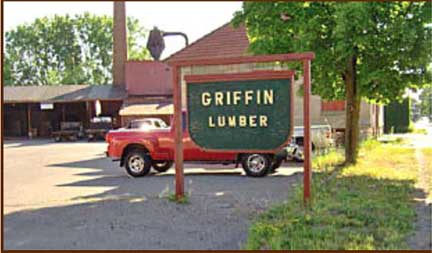
The rest of that winter was about the most discouraging period that I ever experienced. The work and everything was strange to me. I only received $6.00 per week for a 60-hour week and had to pay $3.00 weekly for board and room in a distressful 3rd rate boarding house. My room was cold, without any heat whatever, bare walls, very scantily furnished and no indoor sanitary conveniences and, while the table fare was clean, it was meager and very plain and without variety.
I was so homesick that one Saturday night, after work, when it was snowing hard and the snow 6 or 8 inches deep, Brother Bert and I walked home to the Adamsville farm, a distance of 7 miles. Father took us back Sunday night but as a result of that exposure, I became sick in bed with no one to care for me. Finally, word was gotten to my parents and Father came after me. Was housed up at home for about a week but Mother’s good nursing put me back on my feet again and of course back to work.
Late that summer I changed my boarding place to Mrs. Marion Crawford’s #18 Willow Street, where it was much more homelike. Continued to live there until the spring of 1904 when I had to live nearer my work due to an entirely new change in it. In March of 1904 I changed from office work to work outside in the lumberyard.
My office work had become so exacting and required so much Sunday and night work that I interviewed Mr. Griffin and requested a change.
In those days there were scarcely any modern conveniences in Griffin Lumber Co.’s Office. When the whistle blew at 6 P.M. (the day then was from 7 to 6) the heat, which came from the mill was shut off, likewise the electric lights. Consequently, I worked many night and Sundays with nothing but a round burner kerosene oil stove for heat and no light at night except a smoky kerosene office lamp.
Collecting of past due debts became my job for 2 months after January 1st, 1904. This I did in Sandy Hill, Glens Falls and Ft. Edward and outlying districts by means of the Hudson Valley cars and shanks horses. More than once, to make these collection calls, I had to walk through the snow 2 or 3 miles out in the country, only to be disappointed by not finding my party at home or possibly they didn’t have the money, sorry but call again. During this period, I was told that on March 4th I would be assigned to an outdoor job in Griffin Lumber Co.’s lumberyard. With this in mind I again changed my boarding place on or about March 1st so to be nearer my work.
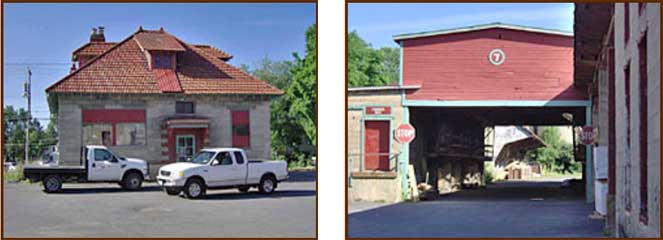
XVIII. Joining a Literary Club
In the fall of 1900 I was invited to join a literary club that was being organized by some of the high school students and 3 members of the high school faculty. The three faculty members were Miss Mabel Daggett, Miss Katherine Buchanan and Mr. George Ingalls. They were our counselors, chaperones or what have you but became our best members for fun or any serious work.
The club didn’t get organized until after January 1st, 1901 and it was christened the “E.K.E. Club,” the initials for the Greek word meaning 21, which was our number when we organized. The original ones were as follows: Ruth Ambler, Myrtle Agan, Frank Eastman, Helen M. Ferris, Mabel Greer, Grace Holman, Ethel Ingalls, Ora Johnson, Clarence Latimer, Irving Walker, George L. Wier, Lemon Washburn, Elizabeth Whittemore, John W. Whittemore, Herman Stoddard, Harry MacMore, Ezra Talmadge, Katherine Buchanan, Mabel Daggett, George Ingalls and a young man from Hartford by the name of Woodell. Harry MacMore and Woodell came only a few times or not at all after the first meeting so the second year Will Bowen, Adelaide Devine and Alton Minton joined.
The club met regularly weekly or once in two weeks, and in this way I became acquainted and commenced to have a good time. The girls were always assured of an escort home as Prof. Ingalls insisted that we draw a name from a hat and whoever that girl might be and no matter where she lived, it was our job to see her home. While I’m sure we enjoyed it, we had to accompany Myrtle Agan to Moss Street and Grace Holman to her home down near where the Griffin Colonial Office stands. It was a case of walk in those days.
This club lasted for the next two or three years until these high school students graduated and some left for college.
XIX. Married Life
From the associations of this club my acquaintances broadened and eventually gave me all of the social activity that I was able to cope with together with work. EdithI attended basketball games, sleigh rides, dances, hymn sings, courting parties, bicycle riding parties, picnics in the evening, buggy riding and other functions but never did much real courting until 1903 when I met the girl who later became my wife Edith Annabel Williams.

The wooing of Edith on my part continued uninterrupted until October 16, 1906 when I had the honor of taking her as my wife. These three years that I dated Edith were very happy ones for me. She was away about 40 weeks of each year, teaching school, but it was my good fortune to be with her weekends and I improved my opportunities.
During the time that Edith was away those three years neither of us felt obliged to pass up a date if it came our way.
The early years of our married life were lean years, having had to buy everything on credit. My income, when we were married, was $13.00 per week if I worked a full week. For 10 years or better we had to deny ourselves any and all luxuries and stick strictly to the essentials.
About 2 years and 7 months after we were married, our daughter Marjorie, was born. John MarjorieWe always strove to give her a normal life, clothing her equally as well as her girl acquaintances, giving her a fairly liberal education, the completion of a high school course in 1926, graduated at Bradford Junior College in 1928, and in June of 1929 completed a year of special work at Columbia University, New York City.
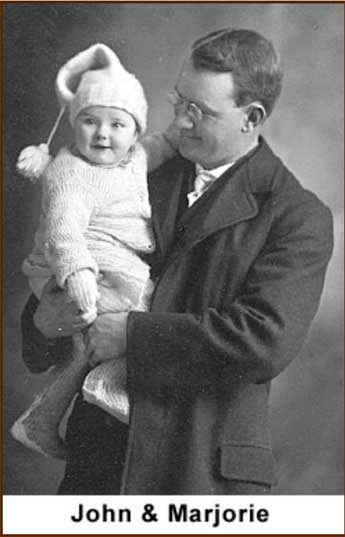
During all of these years we have been fortunate in having pretty good health. Edith, Marjorie and I, all have been hospitalized once or twice but for nothing too serious I hope. MarjorieBoth Edith and I have had accidents which required medical care but nothing that caused any serious injury.
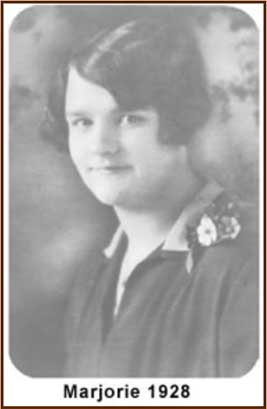
Mr. Griffin slowly but steadily pressed responsibility and authority on me and in the course of time I became a scaler and grader of lumber and logs. I then was promoted to yard boss and later general superintendent, a position I held throughout the remaining years of my service. I was a director of the Corporation for over 36 years and vice president the last 6 years of my active connection with the Company. My service with the Company was for 56 continuous years.
For many years I had to bring my work home nights and devote from one to two hours figuring out how I was to use the men and horses next morning. When morning came I used to arise early (often at 4). Prepare my own breakfast and many times be at the office by 6 A.M. In those days I had 20 or 25 men and 12 teams of horses to keep busy.
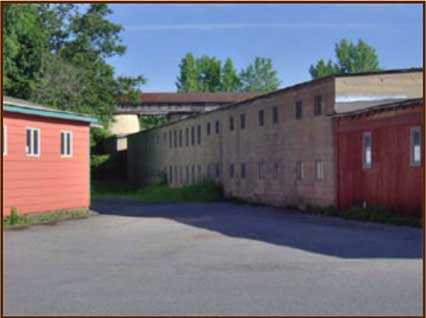
XX. Vacations with Mr. Griffin
At about 1918 as my memory serves me, I was started on annual vacations of varied duration, but usually one week or less. This was apt to be a trip with Mr. Griffin somewhere with all expenses paid. I recall 6 trips into eastern Canada, 3 of which Edith was included.
The first of these trips was with Mr. Griffin alone which was done by train and Pullman and took us to Montreal, Quebec, Campbellton and Dalhousie, way down East on Chalrus Bay. We put up at the best hotels and traveled first class in every respect so just imagine what an experience for me, not being at all accustomed to such fare.
Our next trip to Canada was in Mr. Griffin’s 8 passenger automobile with a party of 8 consisting of Mr. and Mrs. (Grace) Griffin and daughter Mary, Brent and Berry Taylor and Edith, Marjorie and me. Twice we made the length of Eastern Canada by automobile to the Gaspe Peninsula, crossed the Gaspe and made our return through New Brunswick, Maine and then different courses home, once via Boston and once via White Mountains.
Mr. Daniel Griffin was a wonderful host and even though most of his trips were primarily business ones, he never failed to include in his plans entertainment for his guests, no matter how many there were.
Besides these Canadian trips, Mr. Griffin included Edith and me in a business trip that he and Laurence were making to the coal mines of Pennsylvania. From there we went on to Niagara Falls, covering an absence from home of over a week.
Another trip he took with Laurence, Edith and me, which was purely pleasure, was to Boston, Plymouth, Provincetown, Cape Cod and some other historical points. And then another pleasure trip that he took with just Edith and me, and one that we never will forget, was one that we started on October 16, 1931 and ended on the 20th. After having our dinner that day at the beautiful Hotel Bancroft in Worcester, Mass., we continued on to Fall River, Mass., where his daughter, Mary, who was with us, left by train for Boston. Then Dan, Edith, and I proceeded to New Bedford where we stayed all night at the hotel, The New Bedford. The next morning, which was blue and sparkly with a pretty cloud effect, we boarded our ship at 10:30 for Martha’s Vineyard and Nantucket.
I’m neither an artist or an author but to describe this trip adequately would require the talent of one or both. The pleasure we experienced on the short rather rough voyage, the thrill of exploring those narrow, irregular and interesting streets of Nantucket with their cobble pavement, the luxurious growth of all plant life, especially the English ivy, the beautiful coloring of the cranberry bog, the largest one in the world, the imposing looking Sankaty lighthouse which has many interesting facts concerning it, the doll-like appearance of Siasconset, the artists and writers colony with its tiny little houses all of which are artistically decorated, including natures adornment of beautiful blooming roses, climbing everywhere even to the top of the roof of those tiny houses. All this and many other items of interest would be a story in itself and far beyond my power of description.
Griffin Lumber Co. has been for many years, and still is, represented at the Annual Northeastern Lumbermen’s Convention. On several occasions, Edith and I were included in this delegation. We had the pleasure of attending one in Boston, perhaps a half dozen in New York, and I attended one Syracuse with other men. Many of these conventions we attended with Mr. Griffin. He also took us on many of his short business or pleasure trips, picking us up for an evening or Sunday ride.
The evening before he went to Boston to enter the hospital, from which he didn’t return alive, he took me on a little business trip to Ft. Ann.
He entered the hospital about May 30, 1938. Different members of the family visited him periodically. Thompson and I went to Boston to see him in July. We were there for 2 or 3 days and we found him in such good spirits that we felt quite encouraged when we left. It was at this time that he mentioned to me that we must repeat our Nantucket trip and seemed to be very enthusiastic about it. However, he never regained his health but passed away August 26th the following month.
THE END OF THE VOYAGE
When the voices call in the water’s flow,
And the night stoops down to embrace the day,
I shall slip my moorings and sail away.
Through the purpling shadows that darkly trail
O’er the ebbing tide of the unknown sea,
I shall fare me away with a dip of the sail,
And a ripple of water to tell the tale
Of a lonely voyager sailing away
To the mystic isles, where at anchor lay
The craft of those who have sailed before
O’er the unknown seas to the unseen shore.
A few who have watched me sail away
Will miss my craft in the busy bay,
Some friendly barques that were anchored near,
Some loving souls whom my heart held dear,
In silent sorrow will drop a tear,
But I shall have peacefully furled my sail
In moorings sheltered from storm and gale,
And greeted the friends who have gone before,
O’er the unknown sea to the unseen shore.
O’er the unknown sea to the unseen shore”
At 11:30 A.M. on February 17, 1958
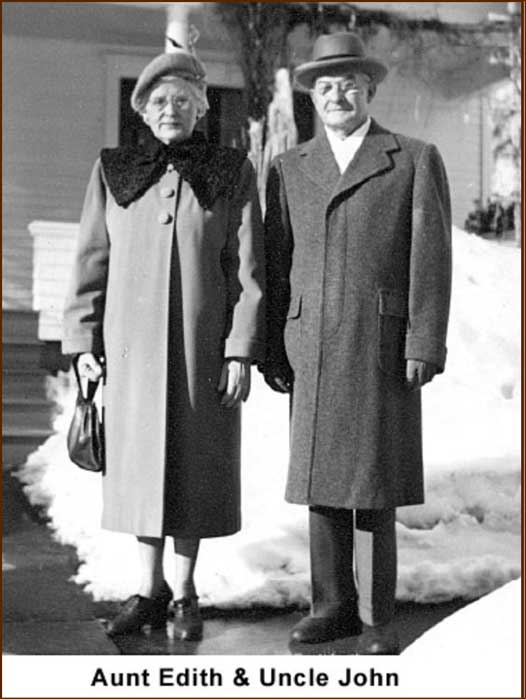
(For further information on this document contact Ernie Danforth
PO Box 252
Corning, New York 14830
danforth_e@corning-cc.edu
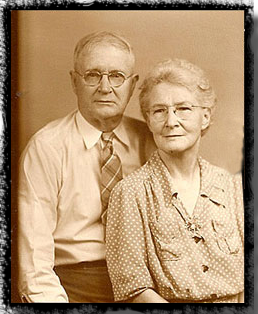
about contributing...reach out here:
